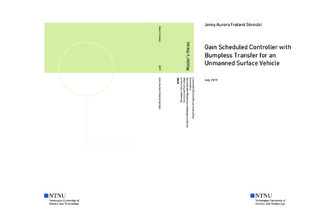| dc.contributor.advisor | Johansen, Tor Arne | |
| dc.contributor.advisor | Kemna, Stephanie | |
| dc.contributor.author | Steindal, Jenny Aurora Frøland | |
| dc.date.accessioned | 2019-10-31T15:01:33Z | |
| dc.date.issued | 2019 | |
| dc.identifier | no.ntnu:inspera:35771502:17101480 | |
| dc.identifier.uri | http://hdl.handle.net/11250/2625665 | |
| dc.description.abstract | Denne masteroppgaven er basert på prosjektoppgaven “Systemidentifikajson av et ubemannet overflatefartøy med to faste propeller”. Prosjektoppgaven legger frem en metode for å finne modellparameterne til en autopilotmodell for Maritime Robotics sin minste overflatefarkost, kalt "Otteren". Autopilotmodellen er en første ordens Nomoto modell som beskriver sammenhengen mellom kursrate (yaw rate) og inputmomentet fra thrusterne. Basert på flere forskjellige “turning circles” gjort ved forskjellige hastigheter ble det funnet to Nomotomodeller for lav og høy hastighet.
Disse to Nomotomodellene danner grunnlaget for denne masteroppgaven. Modellene blir brukt til å lage en linear quadratic (LQ) kontroller for både høy og lav hastighet. Dette er en ulineær kontrollmetode kalt “gain scheduling”, der det ulineære systemet blir linearisert rundt diverse likevektspunkter og lineær kontrollteori blir brukt innenfor det lille området lineariseringene er gyldig for. Resultatet blir flere lineære kontrollere som må bli byttet i mellom ved hjelp av en variabel som fanger opp ulinæritetene til systemet. I denne oppgaven blir det byttet mellom de to kontrollerene basert på hastigheten til fartøyet. For å forhindre uønsket sprang i pådraget til båten når det skiftes mellom de to kontrollerne, har det også blitt implementert en “bumpless transfer”-teknikk for å forhindre dette.
Modellen som er brukt for å simulere dynamikken til Otteren, er en interpolering av modellparameterene til de to Nomotomodellene. Interpoleringen styres med hensyn på den simulerte hastigheten til Otteren.
Gain scheduled kontrolleren ble sammenliknet med en enkel LQ kontroller for å sjekke om gain scheduling er en god kontrollmetode for Otteren. Resultatet var at gain scheduled kontrolleren ikke har bedre ytelse enn en enkel LQ kontroller. Modellene som ble brukt i oppgaven baserer seg på at Otteren er utstyrt med en sonar. Dette gir Otteren et lite hastighetsområdet fra 0-2 m/s. Det ligger en stor usikkerhet rundt den matematiske modellen av Otteren. Otter USVen er egentlig et ulineært system, men simuleringene er basert på en lineær model som er 100\% lik de linære modellene kontrollerne er basert på. Dette gjør det vanskelig å konkludere endelig.
Alle simuleringene i denne oppgaven er gjort i matlab/simulink, i tillegg har jeg fått tilgang på noen akselerasjonstester gjennom Maritime Robotics, som ble gjennomført høsten 2018. Denne dataen ble brukt til å lage en omtrentlig modell av hastigheten til overflatefarkosten. | |
| dc.description.abstract | This master thesis is based on the project report "System identification of an unmanned surface vehicle with fixed thrusters". The project report proposes a method to find the model parameters for an autopilot model for Maritime Robotics smallest unmanned surface vehicle, called the Otter. The autopilot model is a first order Nomoto model, which describes the relationship between the yaw rate and the input torque from the thrusters. Based on several different turning circles executed at different velocities two Nomoto models were found for low and high velocities.
The two Nomoto models are the foundation for this master thesis. The models are used to make a linear quadratic (LQ) controller for both high and low velocities. This is a nonlinear control method called gain scheduling, where the nonlinear system is linearised around several different equilibrium points. When the system is linearised, linear control theory can be used in the neighbourhood of the linearisation. The results are several linear controllers that can be switched between by using a variable, which captures the nonlinearities of the system. In this thesis the controllers are switched between by using the USV's velocity. To avoid sudden jumps in the controller output when the controllers are switching a bumpless transfer technique is used to prevent this.
The model that is used to simulate the Otter's dynamics is an interpolation of the model parameters for the two Nomoto models. The model parameters depends on the simulated velocity to the Otter USV.
All simulations in this master thesis are done in Matlab/Simulink. In addition I had access to acceleration tests executed by Maritime Robotics Fall 2018. This data was used to make an approximate model of the Otter USV's velocity.
The gain scheduled controller was compared to a static LQ controller to check if gain scheduling is a good control method for the Otter. The result was that the gain scheduled controller did not have a better performance than a static LQ controller. The models that were used in this thesis are based on the Otter being equipped with a sonar. This gives the Otter USV a velocity space of 0-2 m/s. There is a big uncertainty for the mathematical model of the Otter USV. The Otter is a nonlinear system, however, the simulations are based on a linear model, which are 100\% the same as the linear models the controllers are based on. Furthermore, based on the results in can be concluded that a gain scheduled controller with bumpless transfer is not better than a static LQ controller. | |
| dc.language | eng | |
| dc.publisher | NTNU | |
| dc.title | Gain Scheduled Controller with Bumpless Transfer for an Unmanned Surface Vehicle | |
| dc.type | Master thesis | |
